July 31, 2004
Bulgarian Horror
Bulgarian Border Crossing
Today started out just fine. We had a nice breakfast at our hotel. I finished preparing my web log entry of August 30. We checked out and went to an internet store, where I posted my second Bulgarian entry. I thought it would be the last from Bulgaria. Little did I know how wrong I was. Finally we headed for the ferryboat. We had actually come to Vidin thinking that there was a bridge here; alas, no bridge.
In my last posting, I talked about the horrible Turkey-Bulgarian boarder crossing. True to form, the Bulgarian side of the crossing to Romania was another horrible and frightening experience.
We arrived at our departure area at 12:40. As always, a guard or immigration officer looks at our passports. We were directed to a waiting area. Two cars were soon lined up behind us. I had gotten out of the car looking for direction as to what to do. A customs officer in uniform took the passports, and we continued to wait. As I said last time, speed and efficiency is the last thing on their minds. Before long another customs officer, at least one might think he was - based on the word customs printed on the back of his black t-shirt. Yes, unlike the other border personnel, this guy was not in uniform and had no badge. He looked in the trunk of our car, messed with the wine, and seemed to be satisfied. Once again, I cannot figure out why customs has any business bothering us as we leave a country because that is a job of customs upon entry into a country, but I have tolerated the exit searches so far. Somewhere along the way, he asked about where we had been; once again I went through the litany: Czech Republic, Poland, Slovakia, Hungry, Romania, Bulgaria, Istanbul, and back to Bulgaria. Later I discovered that, oops, Istanbul was the wrong answer for this guy. A diplomatic car pulled up beside ours. I guess that he expected rush service, because within five minutes the gate was lifted and his car pulled into the next area and we and the two cars behind us were waved into the next holding area. Soon the customs agent was telling me to back up. He spoke to the driver behind me, and I expected all of them to back up into the previous zone. Wrong, he expected only me to back out of this area. With some difficulty, I complied. Before long he had me parked in front of a building, telling me to enter and he was going to search the car. Let me see: no uniform, no badge, wants me to enter a building - where I expect he will shut the door - and he wants to search my car. No way! I asked him to identify himself and show me his credential. He refused. I asked what he expected to do and why. I told him I was not driving into this garage and he would have to search the car in public for all to see. He did not like this. And I was outraged. In a country where they do nothing but bilk the tourist of money at the border, I saw only more of the same in my future. I drove back to my starting point and waited. Several times I asked him to search the car and give me my papers. He refused to respond. It was clear that he was waiting. As it was, he had called his supervisor, who showed up in shorts and a casual shirt. Too bad that his Saturday afternoon was disrupted. At least he spoke good English and could explain what was up. Surprisingly, when he appeared, so did the badge of customs agent. Unfortunately, he wore it in a way that it made it impossible to even read the number. Forget trying to read names in the Cyrillic characters. So, the chief tried to reassure us that this was all OK under Bulgarian law and that the agent had the right to search the car. I did not feel all that reassured. After all we were on our way out of Bulgaria, why now? How could we be sure that they were not planning to plant shit in the car and then take our money? As far as we were concerned they were way out of bounds. Law or no law, what they were doing was harassing ordinary tourists, simply because they had visited Turkey. Finally I relented. I told Betty to make sure the door of the garage stayed open. The only reason he wanted me to pull in was to check the gas tank, a favorite hiding place for smugglers. Great, in my rented Fiat Punto they think I have put in a new special gas tank for smuggling - what fucking idiots! We got the feeling that the chief knew this was all crazy, but like a good leader he was backing up his man. Five minutes later, we were back in the line to go to the ferry boat. Again we waited for our passports. The police were doing there final check. Their slowness and inefficiency was on par.
Finally we drove down to the boat after one-and-a-half hours. Funny thing, all the cars that we had seen at the start were still waiting on the boat. We drove on to the boat paid our $29 crossing fee and waited another hour or so for the boat to depart. Meanwhile only one more car drove onboard. This is the insanity of crossing the Danube that is about half a mile wide here. But finally we were off, sailing about a mile or two upstream before crossing to Calafat.
The horror was almost over now. Here, there were the typical bullshit fees, first for driving through the port, second for driving through the town. Having relieved us of our $10 we were free to queue for immigration and customs, and the passing went quickly. All this took less than 20 minutes. I must say the Romanians got it right. Still it was now 4:10, three-and-a-half hours to travel three miles.
We tried to change money in Calafat, but nothing was open and there were no ATM's. We headed to Criaova where we found an ATM machine and got a very inexpensive room. A few hours later after a nice meal, our day of horrors was over.
Up until the beginning of the day, I thought it possible that I might return to Bulgaria. I especially liked the Black Sea coast. But now one thing is certain, I plan never to return to Bulgaria. I cannot recommend that any of my friends visit this place, at least for the near future. If one day they change their police state mentality, perhaps then it will be a really good place to visit. Until then I say, "Stay out of Bulgaria!"
July 30, 2004
Sofia and Western Bulgaria
On Tuesday, the Turkish-Bulgarian border crossing was worst ever. These counties have the greatest amount of bullshit when entering or leaving. Add the fact that this is a very busy crossing and it adds up to nearly three hours of horseshit. There is no such thing as customer service here. Everyone is treated like a criminal. For me once again, the worst part is that the people of these counties allow their government to treat them like this. Why three separate agencies, customs, immigration and police, have to check your passport - sometimes more than once each - and other essential documents is beyond me. They have never herd of one stop shopping, and would not want it if they had. After all, most of their jobs would go. This will probably only get worse when Bulgaria joins the EU and they lose their reason to harass people as the tourists cross Bulgarian-Romanian border. Then there are the farcical taxes and fees. At least Turkey was honest about the visa fee, well sort of. It is really just an entrance fee, since they do no background check and keep no real records of your entry. The road tax is another honey. Both Turkey and Bulgaria have them and you must pay them to drive in the country. Bulgaria actually had the gall to charge it twice - as we entered twice. Clearly, it is not road tax, if you must pay every time you enter. The biggest piece of bullshit is the disinfection fee. Why bullshit? Because no one disinfects the car. To me this is the worst sort of corruption, because it is built into the system. And the people allow it to go on. No one really believes that it is their world to make and control.
Press HERE to see a slideshow from Bulgaria.
Inside the Bachkovo Monastery 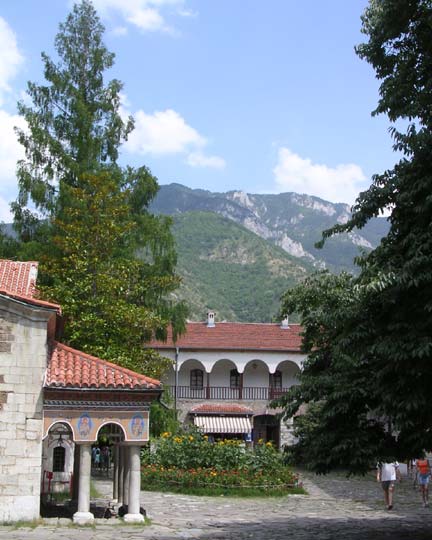 |
Monastery Mural 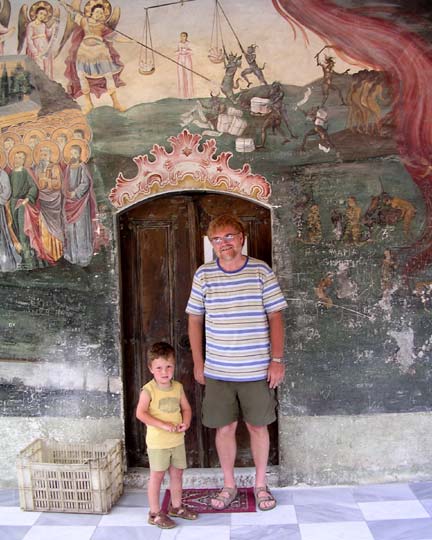 |
It was a good thing that we got early start. Even after the malarkey at the border, we still had time to visit the Bachkovo Monastery. We did not stay long before we headed to Plovdiv. For a change we quickly found private quarters that were good and cheap. After we settled in, we wandered down the main pedestrian street of the city. We stopped for a beer at an outdoor café that sat in front of an outdoor stage. We had heard that there was an International Folk Festival. In no time the performance of three national tradition folk dances were being preformed before us from Macedonia, Italy and Costa Rica.
Macedonian Dancers 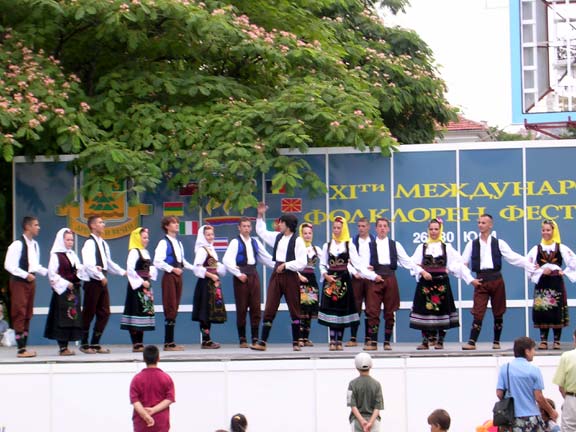 |
Zlatyu Boyadzhiev Painting 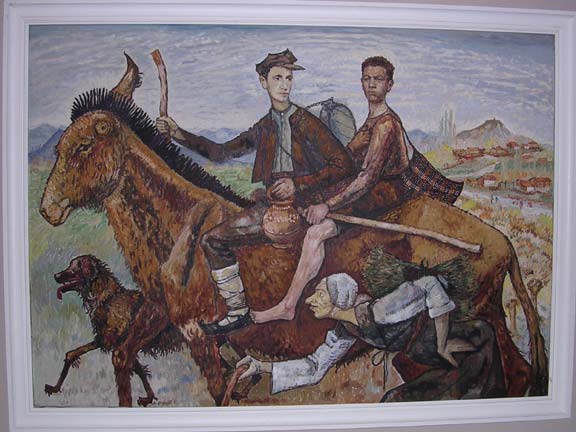 |
We started Wednesday with a walk around Plovdiv. We really only explored the old town. We saw several churches along the way. We skipped most of the museums, but one where the works of Zlatyu Boyadzhiev were displayed in his home, now the museum. We met an old man on the street, an artist selling some of his pieces. We bought a small one. When we reached the old Roman ruins we also reached the highest point in the city. The view was wonderful. Once again I noted that all the post WWII housing expansion was in ten-story flats - surrounding the center.
Shortly after noon we were driving toward Sofia. Two hours later we were getting info about accommodations in the center of Sofia. We were directed to a hotel at the edge of the town. Unfortunately we drove there during rush hour, so it seemed like forever before we got to the hotel. We asked about traditional Bulgarian food and were direct to a nice restaurant a couple of kilometers up the mountain at the base of a ski slope. The food was very good and the atmosphere near perfect. The only problem was that I was in a bad mood. I didn't spread it around (except to Betty) but it didn't make the dinner all that great. I guess we all get in a funk from time to time.
Sofia's Largest Cathedral 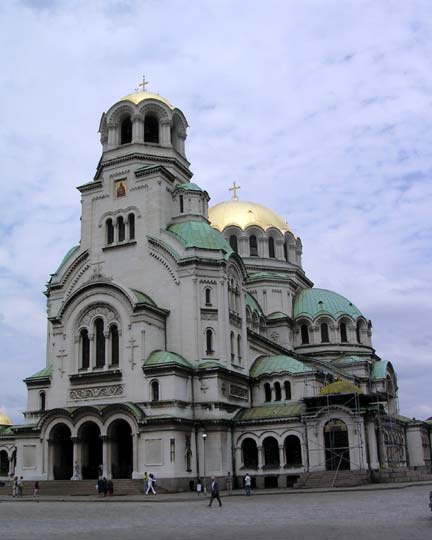 |
Open Air Market 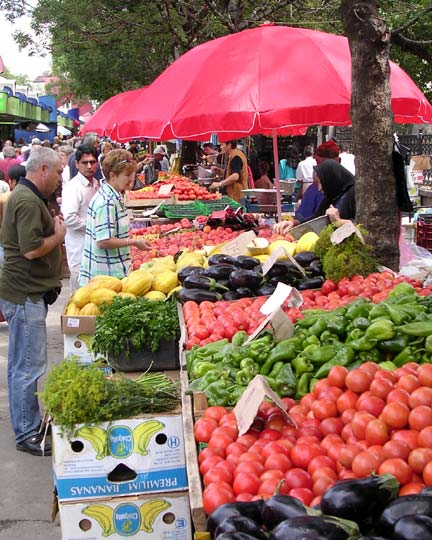 |
On Thursday we had and incredibly pleasant day exploring the city. We saw Sofia's churches, public art, mosque, public baths - now in rehabilitation after 100 years, shopping district, open air market, more churches, national opera and national theater, parks and a flea market. After nearly six hours of hiking around. We decided to take it easy. We went to se a movie, Spiderman 2. It was so good that I could hardly believe it. I just didn't expect it to have such a good script. The other great thing about the movies is that it does transport you back home - if it's an American movie.
Betty begged off dinner, so after returning to our hotel I walked over to the best pub I have been in since the Czech Republic. The food was good and the local black beer on tap was even better.
Julka at Her Loom
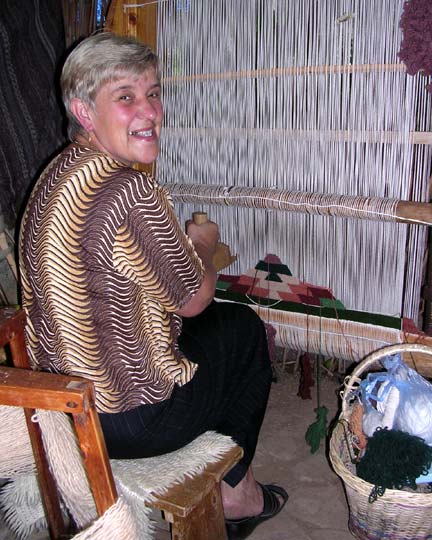
Friday was a very slow drive toward Vidin. We took some small back roads, in some incredibly beautiful valleys by the mountains. We made our way to Chiprovci, a village of rug makers. Nearly every home has a loom and a rug maker. And almost no one speaks English. Then with a little of that magical travel serendipity, Betty was able to communicate our desire to see a loom and a rug maker with a woman. We followed Julka Ignatova to her home to discover that she was a rug maker. Betty watched her work on a rug. Even more luck was with us when she introduced an English speaker who was visiting the rug weaver. We are able to carry on a conversation with the help of her translations. Julka was a lovely person with a wonderful smile and a good heart. Betty bought a piece then we continued on our way on some really terrible roads to Vidin.
We once again found some (maybe all) hotels here that have dual pricing. That's probably why there are no real bargains for foreign travelers here. They seem to think that it is OK to charge a foreigner twice the price of what a Bulgarian pays. If they had the same prices for Bulgarians and the foreigner a lot more people would visit and spend their money here. In any case we eventually found a very nice hotel for a reasonable price. It is the Angelov Han Family Hotel and I can recommend it.
After dinner I wrote most of this entry. While typing away, the TV droned on in the background. I looked up once to see the news being read by two topless women anchors. Moments later the weather lady pulled her clothes off too. Strange country, no?
July 26, 2004
Istanbul and Edirne
Friday we drove over 200 miles to Istanbul. We crossed over the tail end of the Balkan Mountains. Probably at the crest of that mountain line, we entered Turkey. We were surprised to learn that we needed visas, which we got at the border at cost of $20 each. I personally find it irritating to pay and pay and pay at a border, as was the case here for this and that. An hour after entering the crossing zone, we continued down the mountain. The countryside no longer looked like Iowa or Kansas; it started to look like the western part of the US, say northern California. The soil was red in places; the land was more grassland than fields; and the sun shown brightly as it made the land so very hot. The first 100 kilometers was very hard going of narrow winding mountain roads, but the final 250 kilometers went by very quickly on an excellent toll road.
We had a lot of trouble finding our way to an information office. We had a map with several offices marked; the first was closed and the second had no accommodation information. Finally, we found an office, but again the going was tough. This is a city of 15 million, the largest is Turkey; and getting around with no understanding of where the one-ways are or which are closed to cars and no street signs can be a huge problem and very stressful. The recommendation led us to the Ilkay Hotel. The price was reasonable, the room was OK. Since there was a sign say the water was not drinkable, I asked where the drinking water was. "Oh, you must pay for that!" I have been in so many countries and so many hotels in the past three years that I could not believe my ears - drinking water is part of an accommodation. This was the first time that I had ever been in a hotel that did not provide drinkable water. Worse yet, when I questioned this practice they still refused to provide the water. We went out for diner and along the way stopped to check if the other hotels provided drinking water and they said, "But of course." We decided to move to a much nice hotel and set up the move for the next day.
We quickly learned that Istanbul's Sultanahmet district was not a tourist bargain. It was expensive. We made the mistake of sitting down a place with table clothes. The bill was about 42 million lire, or about $30, before we were through. That's right 42 million; there are about 1.4 million lire to one dollar. I received 145 million lire when I changed my first $100. This conversion can be a bit confusing at times. In any case, beer is over priced and the while the food was in the ball park it all adds up way too quickly. Cheap beer is a rare commodity in a Moslem and Hindu countries. For sure every thing costs less in the surrounding neighborhoods. These areas are rarely seen by the foreign traveler.
The Turkish people are very kind and friendly, although some are a bit too ardent in their selling practices. On must be careful not let them take your money, because they will if you're a bit slow on the up take. The rug sellers are the worst, and for sure their profits are the highest. For some reason or another they say that the other side of the Bosporus is Asia. I cannot buy it. As far as I am concerned everything between the Black Sea and the Mediterranean Sea is Europe. The people certainly seem European to me. And if Greece and all of its island are Europe, then so is Turkey.
Press HERE to see a slideshow from Istanbul and Edirne.
The Ayasofya Museum 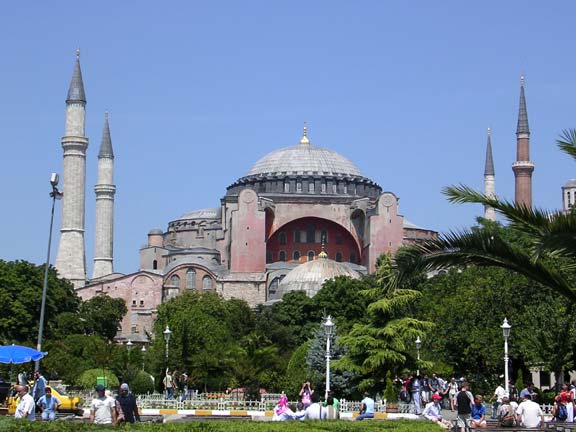 |
Incide the Blue Mosque 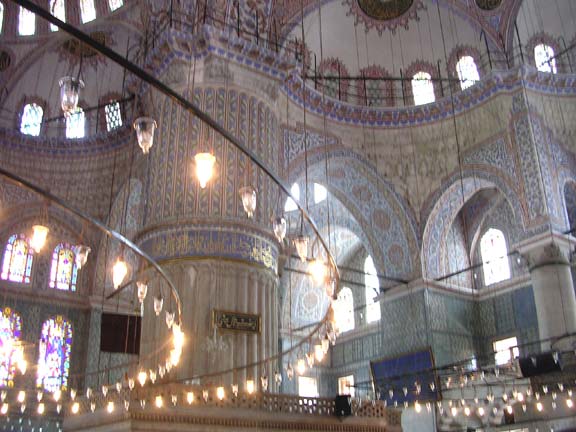 |
Ahmet Metin 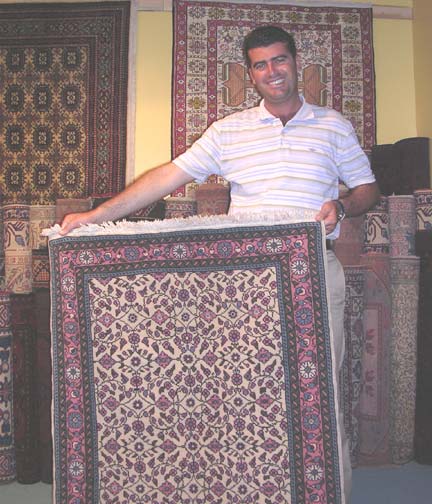 |
Bosporus Fish Market 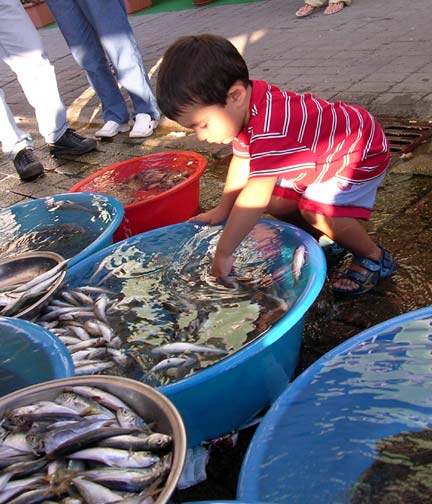 |
A Palace on the Bosporus 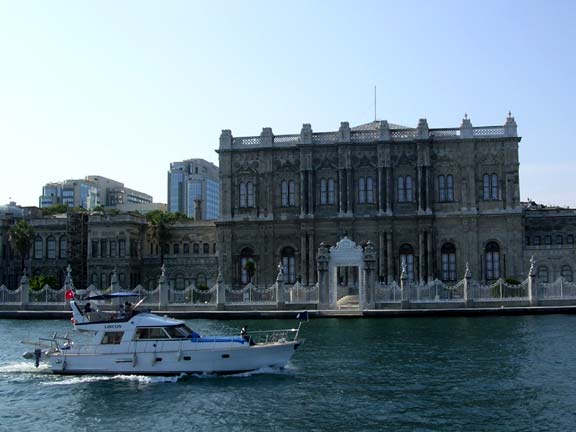 |
The Inner Gate of Topkapi 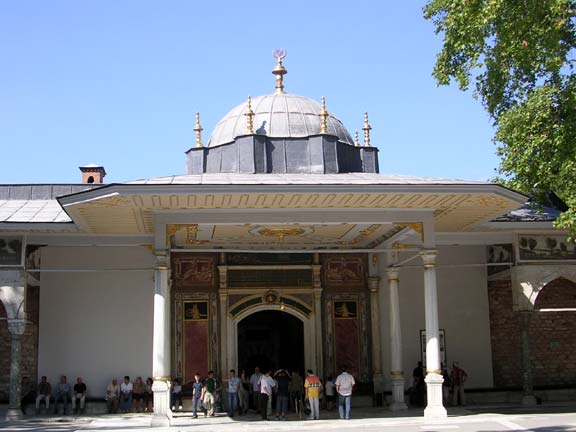 |
After breakfast on Saturday morning, we checked out. The hotel clerk then tried to get an extra $10 out of us for the stay by saying the price was 60 euros and not 60 dollars. This was the final straw; I would never stay at this hotel again. We moved to the Hotel Yasmak Sultan. It is a really nice hotel. Then we set out on some sight seeing.
Whirling Dervishes
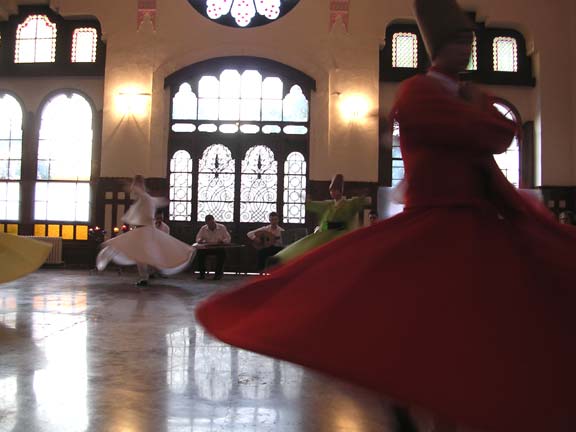
It was just a short walk to the Blue Mosque. It is the second largest mosque in Istanbul, but with the most minarets - six. It is truly a beautiful house of worship. Before we returned to our hotel to rest a bit, we stopped to see the wares of rug salesman, Ahmet Metin. While I cannot speak to the quality of his rugs or prices (we visited no others) I can say that he was a fine salesman with all the qualities that a salesman must have. He might have succeeded with us if we had not been such tough customers.
We did not rest long before we headed to a rendezvous point to connect with a boat tour on the Bosporus. The Bosporus is what made Istanbul a great city and gives her most of her grandeur today. . The boat left the port area about 5:30. The tour guide pointed out the sights of the city as we headed north away from the Golden horn. I love a good water tour. It is a good place to get a perspective of life and this tour was no exception to that. We saw many of the city's universities, playgrounds, and bars, its bridges and expensive homes. After an hour cruising north along the European side, we crossed to the Asian side and before too long made a 45 minute stop. We had beers and some fried muscles before re-boarding our vessel. The tour guide disappeared on our way back to the docks, he got paid. We arrived just before dark. We said goodbye to young Canadian girl that we talked to and a late 20's couple from California. He had immigrated to the US from Turkey when he was about ten and she had originally come from Duluth. Small world, eh? At about $15, dinner was a much better bargain this night. We met a couple of older guys from California at dinner. They were great to talk to.
Selimiye Mosque
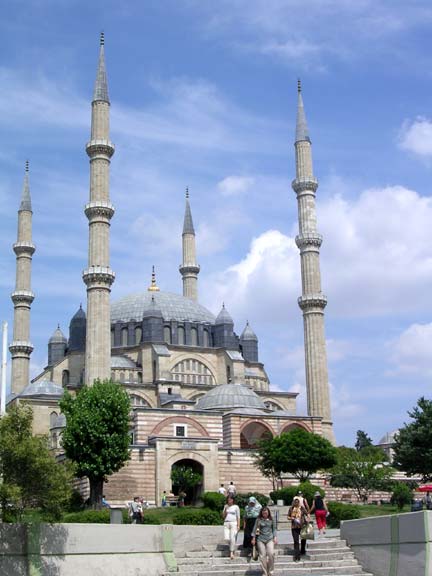
Betty was a bit under the weather on Sunday. So we got a very late start about noon. Because of long lines at the Topkapi, we started at the Museum of Islamic Art. It had lots of very old carpets and decorative objects, but no paintings or sculpture.
We finally got in the Topkapi Palace about 4:00. To see the entire museum it costs about $25 each. We had neither the time nor the inclination to see it all, so we got the cheaper $9 tickets. Basically this is the palace of a lord. And in itself, is an object of interest. The exhibits were pretty good to. I especially liked seeing the clothes of the sultans over time. Betty really liked the display of silver pieces - like the silver model of a mosque. We got back to our hotel at six, which gave us just 45 minutes to rest before going to the train station exhibition room to hear some Turkish or Moslem traditional music and to see the whirling dervish dance. While I like Turkish music, this was not the most exciting music and I felt sorry for the dancers, who essentially whirl for a half-an-hour without any real break. They say that they are in a trance. I would say they must be in a trance in order to not get sick or pass out. Just watching them twirl around and around, gave me sympathetic pains.
We had wanted to see the largest mosque before leaving Istanbul today. It was too far away to walk to, so we opted to check out and stop on the way out of town. Well, it just did not work out, because driving in Istanbul is much easier said than done
So we drove about two hours to Edirne. Along the way we saw a dry countryside with grass and sunflower fields. I am sure that it is green and wet other times during the year. When we got to Edirne we checked into a hotel, then we visited the old mosque, and then the Selimiye Mosque. After this we visited several ancient markets in buildings with leaded domed roofs. We may catch a couple more things before we head back to Bulgaria tomorrow.
July 22, 2004
Bulgaria and the Black Sea
Late Sunday afternoon before we left the Saturn beach near Constanţa, we met Octavio and Mihaela. Like me they were trained as civil engineers, but worked as journalists for years in Timişoara. We had a lovely time talking to them about Romania and how it might and might not change. We were sorry to leave them on the beach and the sinking sun slowly cast ever broader shadows on the sand. If we drive through their city on our return to Prague, we hope to stop and visit.
Press HERE to see a slideshow
from Eastern Bulgaria.
Public Art Found in Near Kavarna
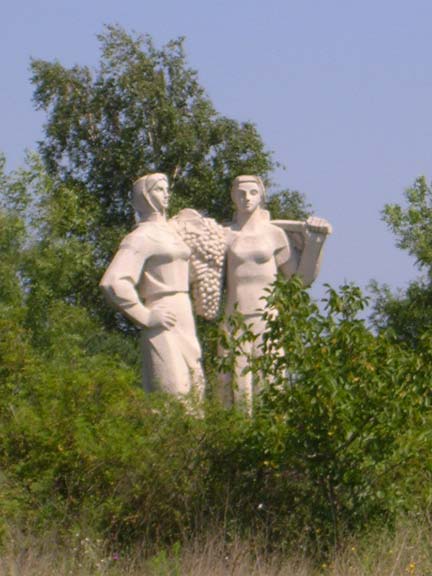
On Monday, we drove south. The fields seemed even more vast and the crops certainly looked in better condition to the Romanian farms. Even though we had merely driven about 100 miles south, the area seemed drier, and warmer. Along the coast there were several very large, expensive resorts - like Albena - where one must pay even to view it. How one would know whether or not it was worth staying at without a look or a discussion with hotel reception was beyond me. Like Romania, they have a funny way of doing business.
It was tough to find a room in Varna, despite all the hotels. We later found out that there is an official tourist information office, but there were no signs that led you to it. I was able to get some info from an information office that was connected to the Odessos Hotel. But by the time I found the recommended hotel it was full. We checked out her other suggestions, but none were acceptable. By the time we figured it all out her office was closed. So we just started looking on our own and mostly a bit out of the city center.
One person at hotel told me foreigners pay 40 Euros and Bulgarians pay 40 Lev. I blew up, because it is 2 Lev to the Euro. Then, tired and late and hungry, we stumbled across the Amfora. The hotel was owned and run by former US exchange student. Although it had been ten years, his English was excellent. The room was great and the service seemed just as good with an OK price, but no cheaper than we have been finding all over Eastern Europe. So, we took the room for three nights.
Varna's Cathereral 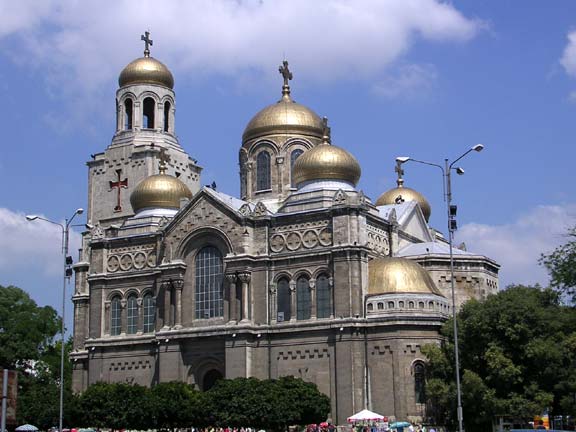 |
World's Oldest Worked Gold 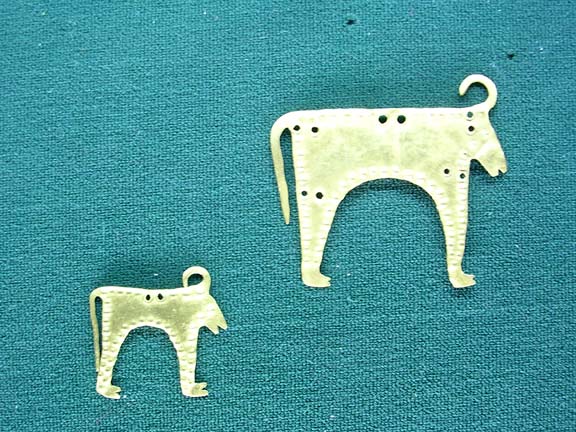 |
Tuesday was used to explore Varna. The archeology museum was a joy, and this is coming from a guy who has seen a fair share of them. Since the area had been settled for more than seven thousand years, they had a very extensive collection, marking all the developments in the area. One of the best things was a large collection of gold objects, taken from tombs. One had almost four pounds of decorative gold. They also had the oldest pieces of gold ever created in the world from the 5th century B.C. We also spent a good amount of time just wandering around on their pedestrian commercial streets. Then we saw the town beach. While the sand was a lot nicer than in Romania, the beach was dirty and un-groomed. This did not stop the thousands of Bulgarians enjoying it or the bars and amusements near by. The five-mile long park that abutted the sea was wonderful and well used by people we saw there. We only walked for a kilometer along its pathways, but still we found the place very relaxing. Upon our return to our hotel, we walked five to ten minutes in search of the beach. Here the beach not only had good sand, the place was clean and pleasant. We only had about an hour of good sun left, but we enjoyed it to the fullest. I even went for a swim. The water was no colder that a Minnesota lake in July. In the evening we ate at a nearby restaurant that had live music every night. They liked to cater to the people present by playing tunes from the customer's country of origin. This was OK, but what they really did well was Bulgarian music. As we have gotten closer and closer to Turkey, the influence of Asia on the music has gotten stronger and stronger. By in large it sounds good.
Wednesday we just took it easy. I had hoped to get some information about flying in Bulgaria, but the guy never showed. The hotel owner told us not to wait for him, he loaned us a phone, and said he would call if the guy showed. So, we spent most of the day on the glorious Black Sea beach. I love these beaches. They remind me of the Danish beaches, only with much warmer water. They are full of families and some tourist, mostly Germans. And this is Europe, so swim suits are optional - although only the children seemed to be bottomless. One thing that I thought was missing in Romania was here - the Banana boat. We also saw people selling stuff on the beach, but nothing like Central or South America. Nor were there any waiters working beach, only guys wanting you to pay for the shade of their umbrellas. I would say they have a ways to go here, but still it is fun.
The Black Sea From Our Balcony
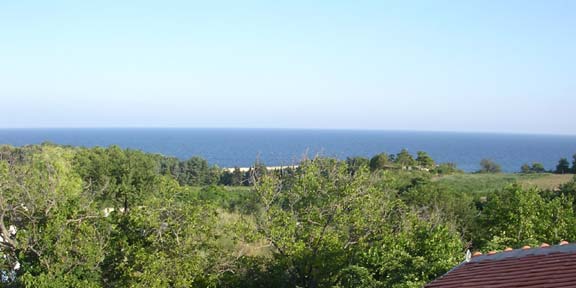
The Best of the Nesebŭr Streets
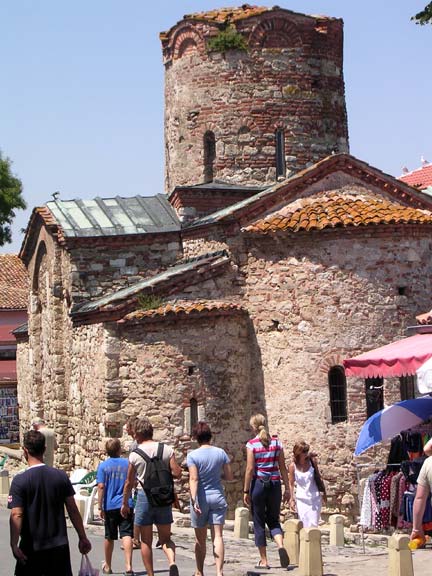
Today we drove south, stopping at several notable, but not thrilling, towns along the Black Sea. The first place that we stopped was Nesebŭr. We thought that this would be a beautiful old town, something like we saw in Transylvania - mainly because it is a UNESCO designated world heritage city. Wrong, the place had a Disneyland feel. True the town was old, but every square foot seemed to be taken up with some sort of commercial activity - from restaurants to souvenir shops to handicraft and fruit sellers. It was almost like being at the state fair. Needless to say we did not spend much time here. Next we stopped in Burgas to try to find a travel book on Istanbul. Despite being less than 250 miles away we could find none. Then we headed south again to stop in Sozopol, which was another huge resort town. Bulgaria has dozens of resort areas that are a bit like Florida - maybe nicer - and they are very crowded. When we got to the place in the road, Tsarevo, where it turned toward Turkey, we continued on along the coast on a smaller and quite dangerous road. Dangerous because it was too narrow and it had little or no shoulder or a shoulder that was six inches or more below the road surface. The scenery here is just brilliant with almost no trees between the road and the sea. The winding expanses of the highland sinking down to the sea were stunning. Finally we stopped at Sinemorets, just a few miles from the Turkish border. It was already late. We looked far too long for the illusive internet connection. We gave up on that and ate a great meal for about $11. Finally the prices are what I thought they would be in Bulgaria. I was thinking about another day here only to enjoy the vistas, but I think Betty will have us on our way to the Sultan's land tomorrow.
July 18, 2004
Wine and the Black Sea
Press HERE to see a slideshow from Romania.
Winery Tour with Iulian and Luminiţa
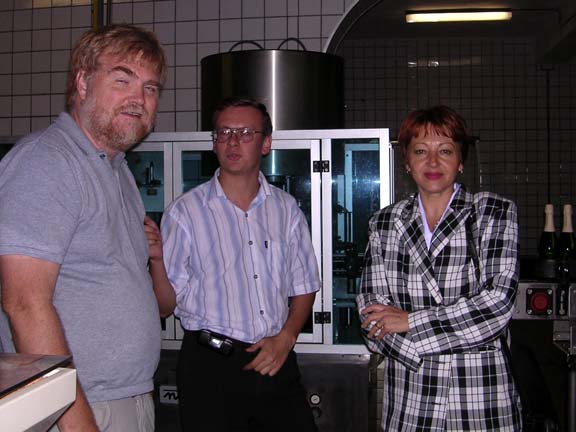
Typical Romanian Wagon
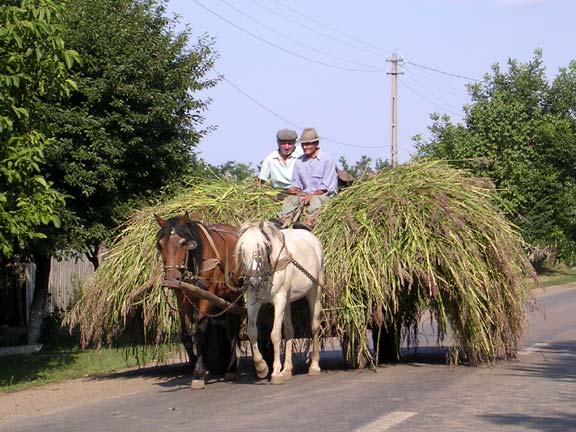
On Friday we drove about an hour to Focşani. I expected to find a tourist information center here, but did not find one. I ended up at the town hall where a very kind fellow, Catlin, told me where the wineries were. He suggested Panciu first. About that time one of his colleges, Camilla, said that she knew the mayor of Panciu. They both said that he would arrange things at the winery. Why this would be necessary was a mystery to me, but what the heck - the mayor would be our guide. Well, Iulian Nica was not the mayor but he was his aide. He set things in motion, and it was a good thing that he did. Romanian wineries - at least in this region - are not prepared for visitors. Since I have visited wineries everywhere in the world this came as a surprise to me. The particular winery that we visited did occasionally have tour buses roll through, but an on going cellar operation was not present. He introduced us to Luminiţa Watkins, the export manager for Veritas Panciu. And she gave us a wonderful tour of a sparkling wine production line, where they have a capacity of 3,000,000 bottles per year. The wine is aged two years; the first year without turning, and the second with the 1/8 turn per day. A winery worker will turn 24,000 bottles in a day. She showed us how they freeze the end of the bottle and then remove the frozen part with the residue or dregs. At the end of the production line we tried a bottle of their brut. It was marvelous, some of the best champagne that I have had - and that is saying a lot because I usually do not like champagne. This very good wine in Romania cost only $8 per bottle. We bought one and one of their sparkling reds too. This was by far one of the best and luckiest connections that we had made.
We went to the next major winery's town - Odobesti, but we could not find any public presence. We asked and found nothing. While it was late in the afternoon, we decided to head toward the Black Sea. This part of Romania has little of interest; it's like Southern Minnesota or Northwestern Iowa, just fields and more fields. The one thing that we did take a hard look at was the people out and about in the villages. Farmers do not seem to have pickups or cars. They use horses and wagons to get around. The smell of horse manure often wafted in our windows. The people seemed to be dressed in clothes from a generation or two before my youth. The roads that led to Bucharest were smooth and flat, while the roads the crossed these were often full of pot holes and a mess to navigate. At one point we saw oil derricks and couple of working oil wells. We were a bit worried now; we had not seen a hotel since we left Focşani. Then well after 8:00 and about 30 km outside of Constanţa, we found a nice hotel and put down for the night. Another thing to note is that we were for the first time at about the same latitude as the Twin Cities.
The Casino in Constanţa
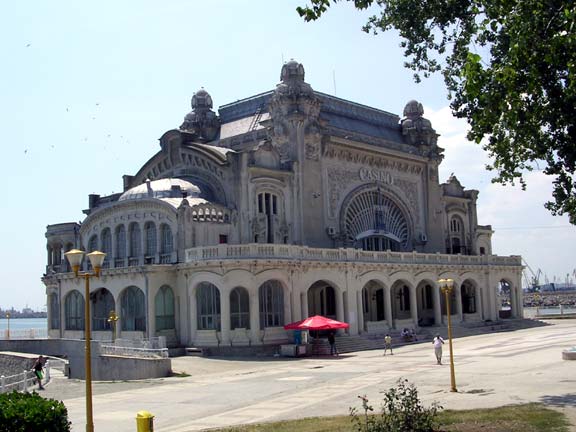
Yesterday we were going to drive through Mamaia, a Black Sea resort area just north of Constanţa's city center. When we saw the booths collecting an entrance tax, I could not believe my eyes. I turned around and we entered the Constanţa from another direction. We have found many odd and sometimes irritating customs in Romania, and I guess I will just add the tax to the list. Constanţa was not what we expected. Like most of the large towns and cities outside of Transylvania, it is a city of one apartment block after another. Its old town did not have that many old buildings. The best one was their Casino that I thought was from the 1800's. We saw some ruins with a Roman mosaic floor from the third century.
From here we drove south about 25 miles to a resort area. The hotels are mostly 30 to 40 years old. Some are very clean others need work, but most are not that expensive for a seaside resort area with nightly rates from $20 to $100. We walked on the beach to find them full of families enjoying the sun and some even the water. The water may be nearly as cold as Superior is this time of year. I thought that it might be 60 degrees or a little more, but I am not great at telling water temperatures. But it was more like a Minnesota lake in early June than mid July. The beach is not groomed and the sand is not that great maybe a bit like the lake sand of many Minnesota lakes. From the waves I would say that there is no surf action to create the sand. In fact, despite a light breeze, the waves were very small indeed. We drank beer and watched the families play.
We will take it easy today. We will try to get some sun and get this posted on the internet. We will head to Bulgaria tomorrow or Tuesday.
July 15, 2004
On to Transylvania
Press HERE to see a slideshow
from Transylvania.
Riverside in Oradea
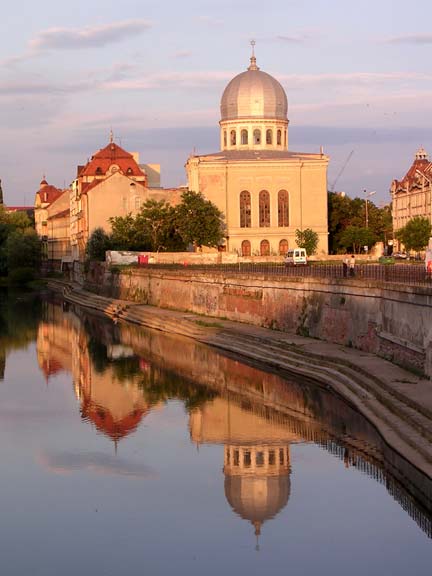
We left Debrecen Sunday about midday. We drove a bit around the city before heading south and then east. About an hour after leaving we were at the Romanian border. When we first arrived at the border we were a bit surprised to see a long line of cars waiting to cross. Until then it had been rare to have even one car in front of ours at a frontier. Then for some reason or another, we all started moving through almost at once. Romania looks much as eastern Hungary at this point. We drove the dozen or so miles to Oradea. The first thing that I did was to change $200 for Romanian Lei. Now I was a millionaire with 6,500,000 Lei - wow! The excitement quickly abated when I found a very inexpensive hotel and paid 650,000 Lei for the room - oh well! Much of Romania was once part of Hungary, so the center of the city looked a lot like a Hungarian city. Ordena seemed all worn out. It was nothing like I saw in Calcutta last year, still many of the buildings were in desperate need of restoration. Not all the city was like this, we did see a few restoration projects started or completed. We visited a museum. The Romanian painters were good but they made not a great impression on me. The handicraft arts, as always, were very interesting to me. Some of the large modern woven tapestries were stunning. After the museum we walked and drove around a bit. We saw a good number of people fishing in the river that ran through the center of the city. We had a nice dinner of Romanian food, dishes with ham and beans and ham and cabbage. Then we strolled on the pedestrian mall and stopped for ice cream.
A Fortress Church in Sebes
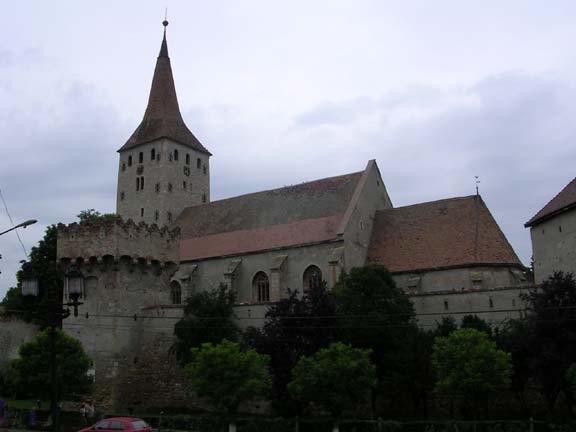
Monday we drove for a couple of hours through the Romanian countryside to Cluj-Napoca. It became hillier as we drove on. The agriculture in Hungary was very modern, using large machinery and large fields. Here everything was done by hand, and mostly with wooden tools. In fact, they were using the same wooden tools that we saw in the museum the day before. The real question is - which is the museum, a building in the city or the countryside itself? Farmers driving horse carts were a common sight and a traffic problem on E60. Before long we drove through forested and near-mountainous terrain. Eventually we returned to an agricultural area, only here is was mostly pastures. It brought back memories of New Zealand. Cluj is a much cleaner and nicer looking city. We had trouble finding a lower priced hotel. They have no tourist information services here. Our Lonely Planet guide was helpful, but the year-old volume prices are way off with most prices 50 to 80% higher. Maybe it is because they too will join the EU in three years. There is not a whole lot to see here. We did look around. It has some great architecture from the 19th century, but it also has loads of the 12-story socialist dream apartments that have the esthetic appeal of a plain block of concrete.
Evangelical Church in Sibiu
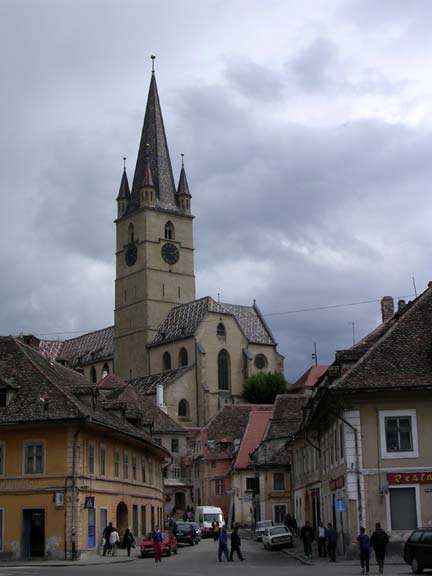
Tuesday we drove for a few hours mostly south and a little east to Sibiu. Along the way we stopped in one city, Sebes, to walk through an orthodox church and to walk around an ancient church with a high wall about it. Interestingly this is the first time that we saw the housing built in the fifty's actually look like it had an architecture that fit the people and the town. In other words, they were three or four story apartment buildings with red clay roofs and stucco exteriors. I digress too much. It was about this time that it started to rain and it would rain the rest of the day, slow steady rain and very cool temperatures not higher than 57 degrees Fahrenheit. One of the best things about Sibiu is that is has a tourist information office. We had thought that there were none in Romania, but in fact they exist in about a dozen locations. The office greatly sped up our search time, and we had a pension in less than an hour. I have continued to be surprised at how expensive accommodations are here, relatively, but with the aid of the tourist office we got a nice pension for a modest price. Its name was Pensiunea Hermannstadt.
One of the first things that we did was ask about a laundry. I really did not expect to hear that one existed, but to my surprise the hotel owner showed me one that was less than a block away. It was more like an industrial laundry, with a dry cleaning service. The shop would wash our clothes by the kilo. Upon our return to the hotel, the hotel owner offered to wash our clothes for about the same price of about $4.50. With that we got our clothes washed.
The day had turned rainy, and despite the rain we went out for a walk and some dinner. The town is truly amazing; in fact nearly all of Transylvania is amazing. In that it is incredibly old with building after building in the cityscape being 200 to 400 years old. Of course, the town square was in need of work and some was taking place. There is a huge German influence in the area. They immigrated to Transylvania hundreds of years ago. Most of the towns have two names, a Romanian and a German name. Sibiu's German name is Hermannstadt. With the end of totalitarian rule in Eastern Europe, much of this German population moved back to Germany in the 1990's, when the German population went from 450,000 to 50,000.
We started Wednesday with a visit to the local museum. We enjoy seeing the art of a country when we visit. After the museum we did a walking tour exploring much of the town center. This included two churches more than 400 years old: the Roman Catholic and Evangelical (Lutheran) Church. Then we made our way to the lower town and an open air market. We returned to the hotel to get the car and drive around the town. In the evening we went to an organ concert at the Evangelical Church. The music was spectacular. The thing that surprised me was the seeming lack of enthusiasm for the music. I wanted to applaud, or at least say "Amen," at the end of each piece. But the audience was silent. In any case, the music was wonderful.
Today, Thursday, we drove to Sighisoara. More than likely, it is most beautiful town in Transylvania. We saw a place Vlad Dracula once lived, a 750 year old church on a wonderful hilltop section of the town. From here we climbed even higher to the church at the top. The only problem in the town was that its main street was seriously under construction, which will soon make the town even nicer.
After a couple hours visiting Sighisoara, we drove onto Brasov. We again had problems finding accommodations. We decided to continue on toward a wine growing region of Romania. We headed off through vast corn and wheat fields, and then we passed through an idyllic forested valley. We saw a couple of new towns finally stopped about 8:30.
A Home of Vlad Dracula 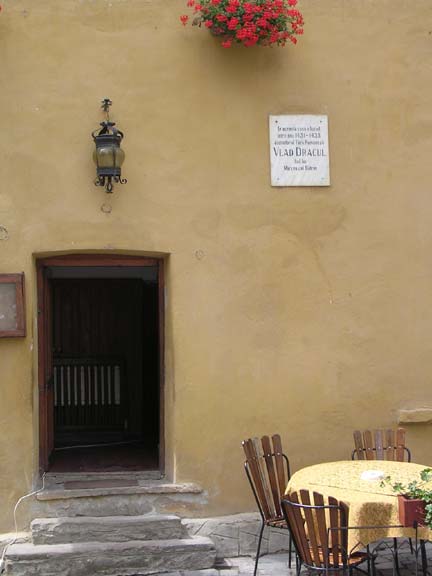 |
Clock Tower in Sighisoara 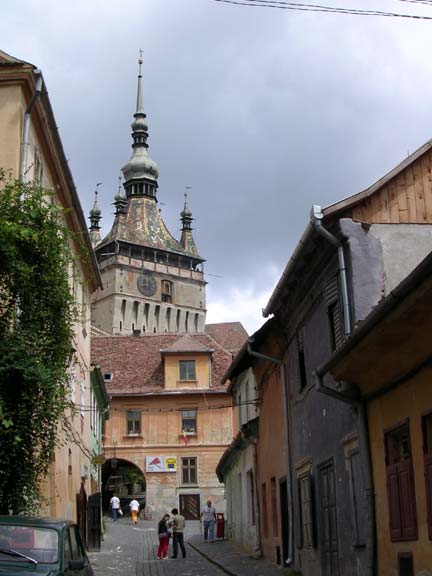 |
Transylvania is by far the most interesting area of Romania. As we left the area the towns seemed all post WWII. Perhaps, they were likely destroyed in the war. Well on to the Black Sea.
July 11, 2004
Car trouble on the Danube
The last few days have been interesting learning experience. It took up way to much time to deal with the problem, something that should have taken care of itself - after all it is a rental car. The hotel receptionist pretty much saw the unfolding events around the bumper damage. We had called the car owner, he suggest that we try to get the hotel to settle the damage claim in friendly manner. He also suggested we get an estimate before trying to settle things with the hotel. So Wednesday morning we got an estimate of just $380. After that we checked out Pest's big green space park. We had planned to meet with the Hotel Carmen's owner between noon and one. We got back to the hotel at 12:30. The owner had come and gone. Was he avoiding us? In hindsight the answer is yes. But our receptionist, Kristina, gave us the name and address of the hotel's insurance company. So, in the afternoon we submitted a claim. We thought that the only problem would be whether or not it could be expedited - after all, didn't the hotel take responsibility when they passed on there insurance companies info? After the insurance company trip we went to Margaret Island. The whole island is a park that sits between Buda and Pest. It is a fantastic park with a hotel, swimming pools, some ruins and a great 19th century water tower. As the day ended we found a great restaurant around the corner from the hotel.
Thursday started with a call to the insurance company, but we got no answer. Then we went to the Buda castle area, which more like a little town on the top a large hill in the center of Buda. The entire area was more than 350 years old. It is probably the most popular tourist attraction in the city. People from all over the world and Hungary were exploring the ancient streets. We did not stay long, it was too Disneyland for us. Then we drove through some of the great residential neighborhoods that roll up in to the hills behind the city. After that we went to Szoborp's Statue Park, a strange place about twelve miles southeast of the city. It's really just a collection of socialist realist art. They charge you three bucks to view them. We met a couple of Italian boys whose fathers' were Communists. They could not understand why we would be there. But really the German couple we met in Eger told us about it and suggested we visit it. The pieces were beautiful and very impressive. We had a nice chat with these young men and we gave them a ride back into the city. We walked in another area of down town that we had not seen before. Pest has some awesome open spaces. It was nearly dark now, and we headed back to our hotel and that nearby restaurant for Hungarian soup and bread
Press HERE to see a slideshow from Hungary.
Castle in Pest's Central Park 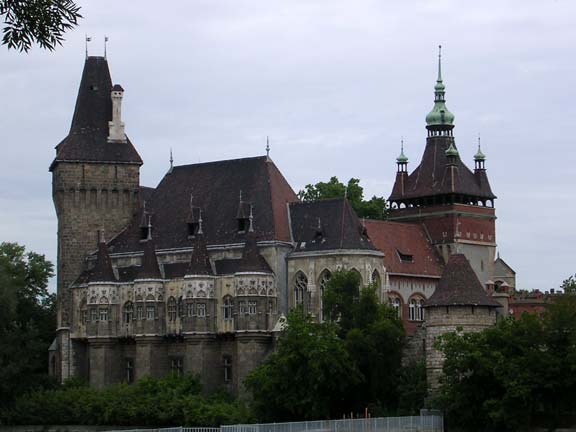 |
Anonymous in the Park  |
In the Budas Castle Area.jpg 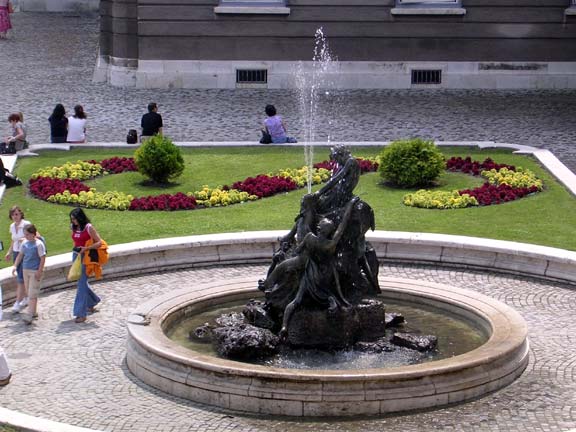 |
The Hungarian Parliment 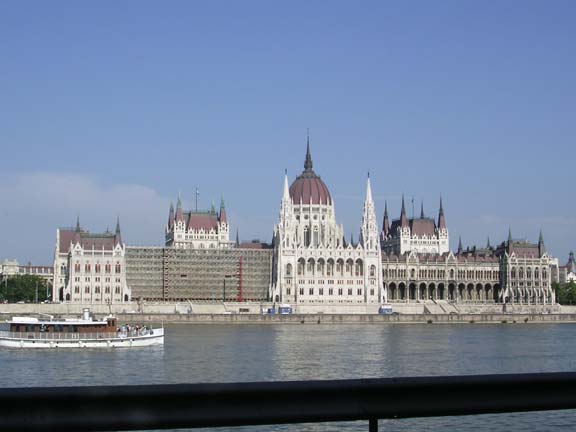 |
Szoborp's Statue Park  |
Peace on Earth 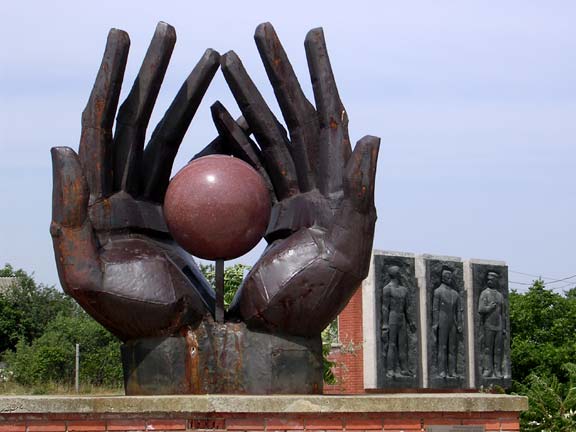 |
Friday was really a day of reckoning. It was Kristina's day off. The replacement receptionist, Victor, did not speak English all that well. He was saying the hotel was not responsible for the damages. I could figure out where this was coming from. So, we drove over to the insurance company. We spent way to much time finding out that the hotel's policy did not cover this type of damage, and that the hotel owner was denying responsibility. Their official position was that since it never happened before, it could not have happened; like we say in the states: "Shit Happens!" We had no choice but to call the police and report what occurred. Of course none of them spoke a word of English. I tried my best, but who knows how they took it. No sooner had the police left than we were asked to pay now. I have got to say the hotel owner and Victor had a lot of gall given what had happened. I called my car rental guy. He said to just get temp fix and he will get it fixed when we return to Prague. God forbid, nothing will happen, because we did not get it fully repaired. The partial fix only cost $30.
We decide to spend the rest of the afternoon on a side trip to Szentendre, a wonderful little town like our Stillwater, except it is only 200 years older. This wonderfully beautiful 17th century village was full of tourists and handicraft sellers. I find that we are getting jaded by all the beauty, and we just are not taking photos like we should. There are just so many great old towns in central Europe. In the evening we went to the movies and saw Dirty Dancing 2. I really loved the Cuban setting and the fantastic Afro Cuban music.
Saturday we took another pleasant drive through the Magyar great plain with fields of corn, sunflowers, and wheat. Another thing that you can see a lot of in the countryside is storks, lots of storks. The mostly make their nests atop the power line poles. But we did see one with six large storks atop a chimney. We arrived in Debrecen where every weekend in the summer it has street programs. We had trouble getting a place but finally settled on a nice pension, Rózsa Motel. The owner's daughter, Katalin, spoke excellent English and we were able to get some good information on the city from her. The city was much bigger than we thought it would be - about 200,000 - with several colleges and some factories. It is the second largest city in Hungary. We were directed to an excellent restaurant called, Flaska. The food was wonderful and reasonably priced. After dinner we went to listen to music in the main square and met some good people. We really enjoyed there company and the wonderful music - a strange mix of Hungarian folk, blues, and Cajun music. The dance that accompanied the music was pretty incredible too. Again it was a mix of traditional folk dance and some pretty modern variations.
On the Danube in Szentenndre 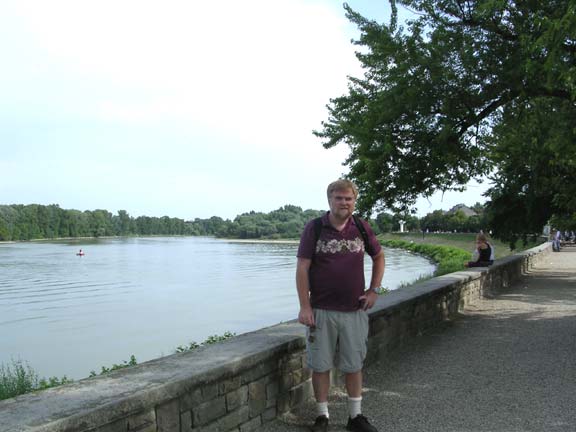 |
Befote the Gate in Szentenndre 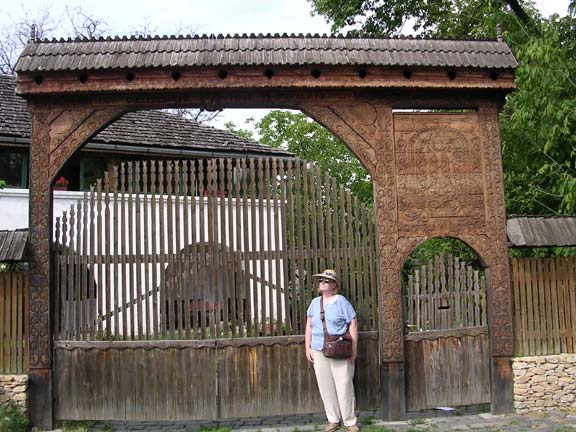 |
Storks' Nest Near Debrecen 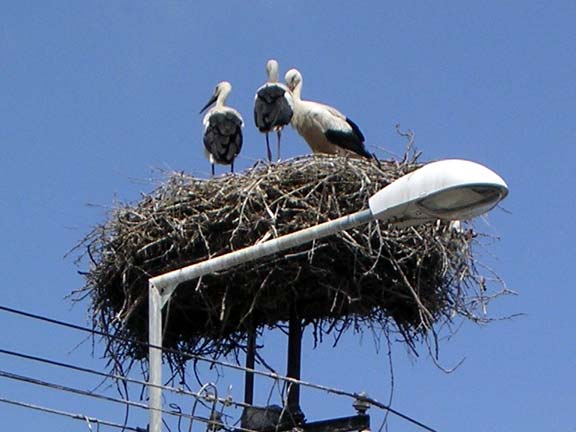 |
Hotel and Fountain in Debrecen 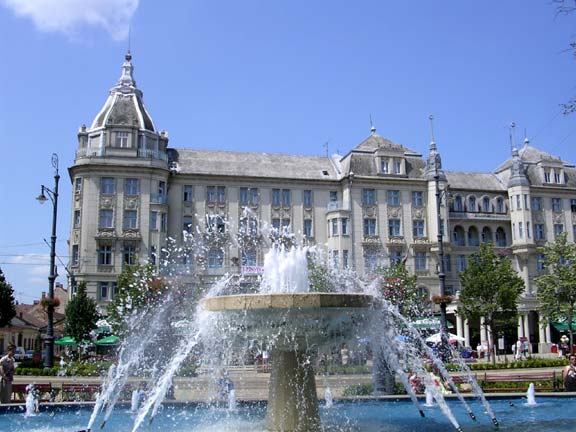 |
July 06, 2004
Bull's Blood
After leaving Tokaj on Sunday, we drove back through Tarcal and head west though Szerencs, Miskloc, and several small towns before turning to Eger. The countryside was fairly flat. The crops were corn, wheat, oats and lots of sunflowers. It reminded me a lot of southern Minnesota.
Eger is another medieval town with a large fortress where they once defeated the invading Turks in the 1500's. The Turks did take and occupy the city for almost 100 years, but still they are very proud of the earlier victory. In the evening we wandered around in the fortress, before stopping for a pizza and beer.
On Monday, we spent several hours, walking from one historical building to another. The most beautiful buildings were built after the expulsion of the Turks and starting in the mid 1600's. It was a hot day and the sun was getting to Betty, but we pushed on.
Eger is also famous for its red wine, commonly called Eger's bull's blood. The town has many commercial and family cellars. Unfortunately only few of the family cellars were open. The wine was excellent. My only disappointment was that there was so few to try. We did discover a first rate restaurant that also had a cellar. If you ever are there you might want to visit, it is called Talizman-Tulipánkert Étterem. We had a bit of soup at lunch and decided to return there later for a full meal. As the sun was setting we went back and had two of the best meals that we have eaten. I had venison with a fantastic cranberry sauce, while Betty had roasted turkey with roasted pears. We met a wonderful couple from Hamburg, Gabriella and Harald. They are cycling through Hungary and will go on to Slovenia and Bosna i Hercegovina. We spent quite a bit of time talking about our lives and the changes that we have seen in the USA and Europe. We wish them a safe journey.
Press HERE to see a slideshow from Hungary.
Eger's Central Square from Fortress 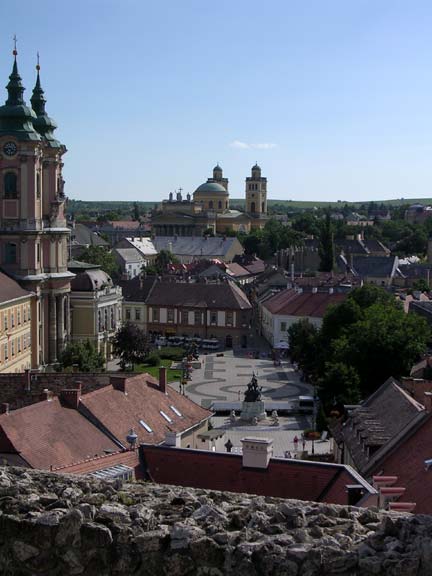 |
Lázló from the Talizman Restaurant 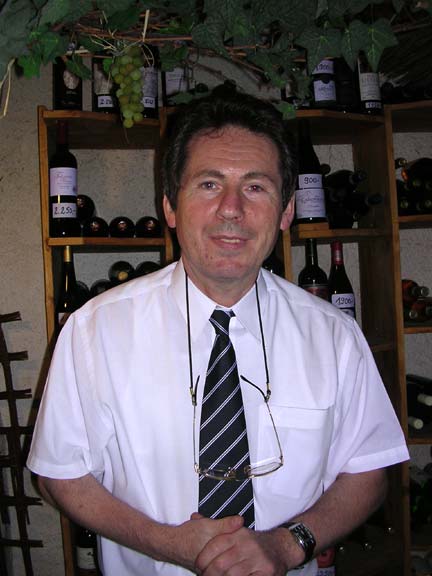 |
In Bartha's Cellar 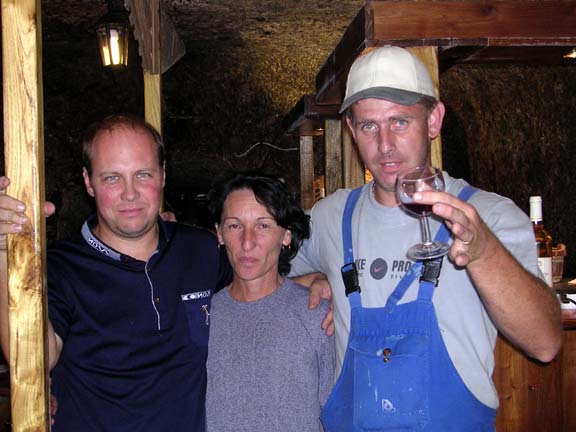 |
Another Cellar 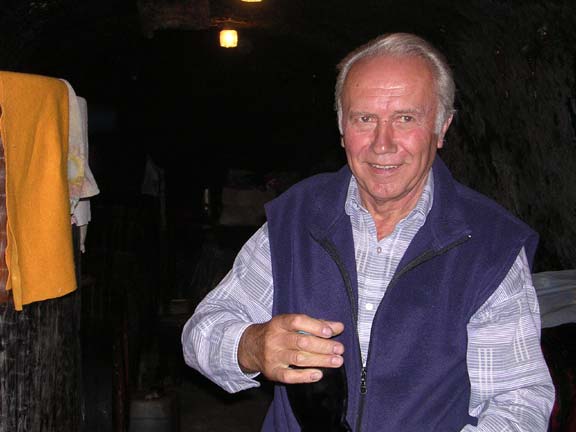 |
Today, we left about nine, headed on the back-roads for Budapest. We passed through forested areas, several smaller towns and finally into Budapest. The city of two million souls is difficult to get around in. The main problem is lack of one ways and restrictions on left turns. If you do not know your way around it can take along time to drive just a few miles. Also there is a lack of public parking in some location. We ended up going to three information places before we could get recommendations for a place that we wanted to stay at. One was in Buda so we even got a glimpse of it. By the way, the Buda side of Budapest is west of the Danube River, and the Pest side is east of the river.
After checking in we wanted to head back to the center. We had problem in the hotel parking slots. The bars that lay on the ground in one spot rocked up and caught a bit of the Fiat's bumper. The damage looks very minor but in this day and age - who knows what they will charge to fix the hunk of plastic. Since it was faulty lockup bars that caused the problem, I expect that the hotel will pay for the damage but who knows.
July 04, 2004
Tokaj and the Joy of Hungary
Press HERE to see a slideshow from Hungary.
The Degenfeld Wines
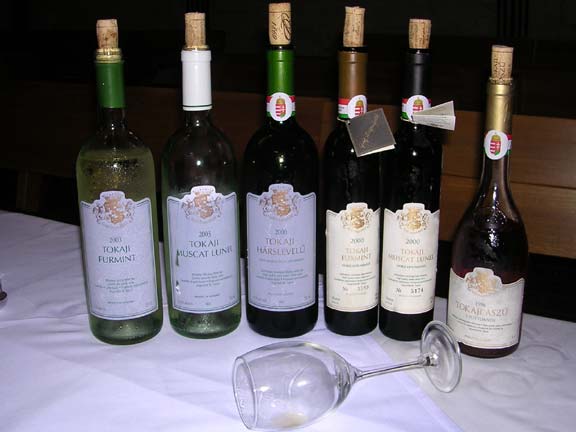
The Kalstrom Winery 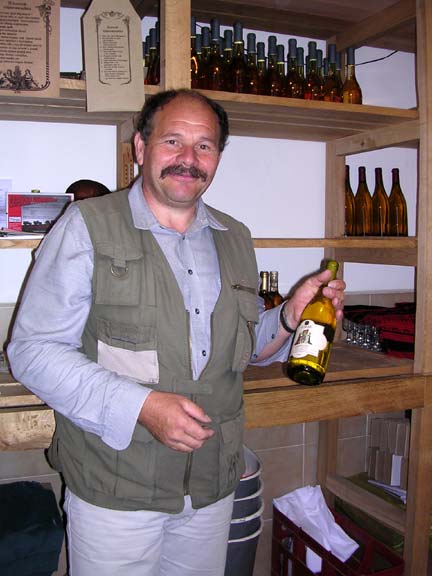 |
A Family Wine Maker 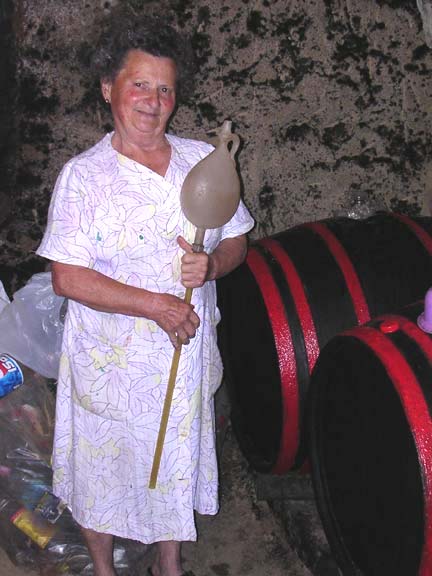 |
Csaba and Bill 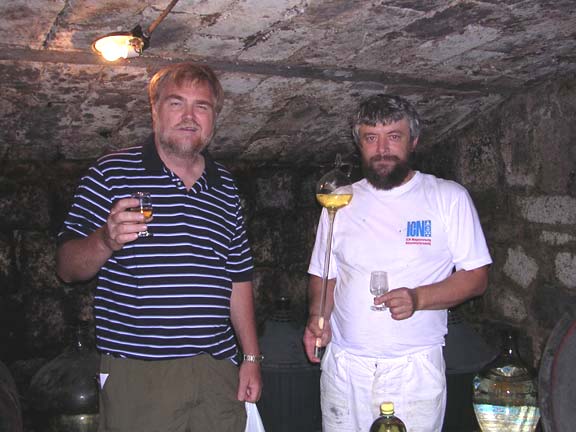 |
On the Wine Trail 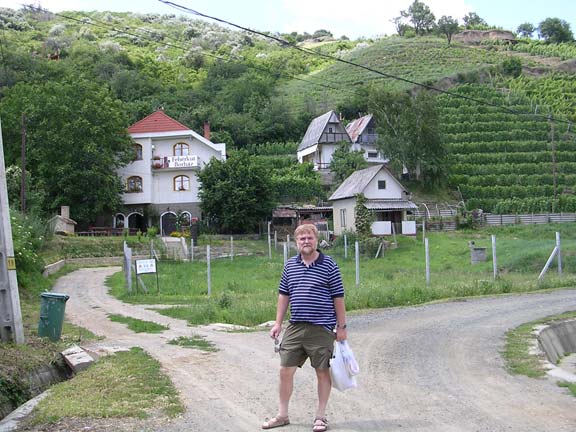 |
At the Fountain of Wine 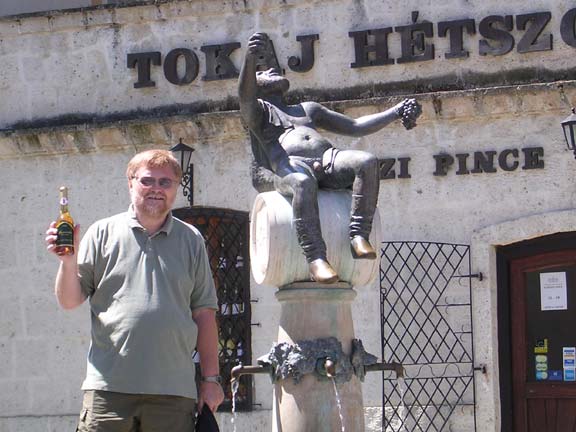 |
Tokaj's Center 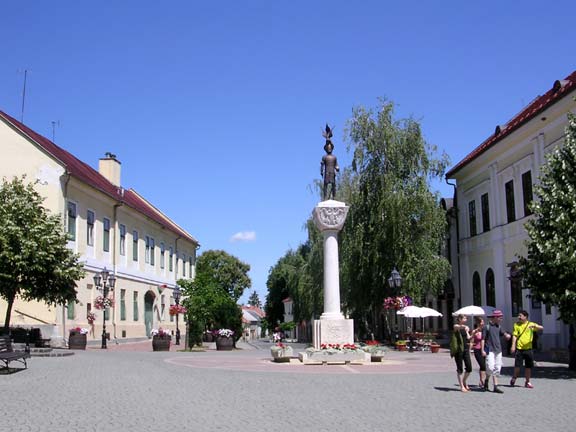 |
We were finally able to get our clothes washed. They still have no laundries, but we were able to use the machine at the house we are staying at. We were a bit surprise at how long it took to wash them, but we finally got one load out on the line and another one started. The lady of the house wanted no money for letting us use the machine, but we insisted she take $5.
Then we were off to find the wine cellars. I had met a store clerk, Vicky, the day before who spoke excellent English. Betty had just finished a book, so we dropped by the store to give it to her. I asked about where to start; there are so many cellars here it is difficult to know where to begin. She directed us to four little family run operations near the train station. After a twenty minute walk we were at the first one. Soon we were tasting and buying and before too long we were feeling the wine. These cellars ranged from a very professional to families selling their excess wine production to the public. For example, the first we stopped at, the Klastrom Pince, was very professional; and the last wine maker was Csaba Simon, who sold the excess that his family did not use. Most of the wines start from about $3 a liter and for the very best the Aszu more than $35 a liter.
The afternoon was not half over and we were back in our room sleeping it off. I was sorry not to have made a second run at it but by the time we were on the street the last of the cellars were closing up shop. We wandered down the street and stopped at the Tokaj Hotel for a wonderful meal of roasted pig knuckle with potatoes. With soup and salad and a bottle of wine the total was less than $30, a lot but well worth it.
The basic cool weather pattern with afternoon rains broke today. It was clear, sunny and warm all day. It's like the movie where when you got to Oz - the gloom and doom depart and the light of world falls upon you. We really love Hungary.
Today we just visited three of the better wineries in the town. Only one was a family operation, the Borostyán Pince. It was the only one that I could call fun. At one we did not even try the wines, because they wanted us to pay for a tasting and I did not want to try six wines - I really only wanted to try their Pinot - the only red one that we saw in Tokaj. Tokaj is wonderful place to visit: small (pop. 5000), comfortable, friendly, and with wonderful wines. If we never return to Tokaj, we can always return with a bottle of its flowery scented and sweet tasting wines. We departed in the early afternoon headed to Eger, which I will write about next time.
The Tokaj Station
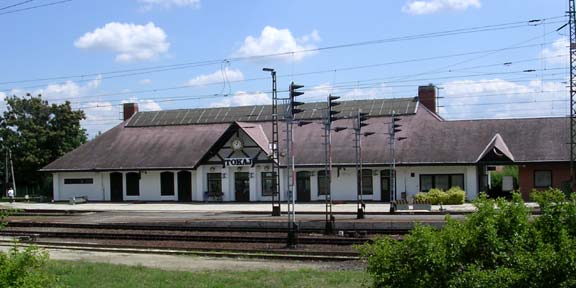
July 01, 2004
Slovakian Disappointment
Press HERE to see a slideshow from Slovakia.
Levoča from the Church on the Hill

Yesterday, We left Kraków and headed south. Before long we were in Poland's Aspen. This area of the Carpathian Mountains has huge granite rock faces. The town was cute and a tourist Mecca. We wanted to ride the lift to the crest to put one foot in Poland and one in Slovakia, but this was not to be, as they did not allow cars to drive up to the lift. Strange, but true; we guessed that they forbid cars to allow taxis, buses and horse carriages to carry tourist to the lift. So we just drove through the mountains to Slovakia.
Like the Czech Republic, Slovakia is a beautiful and clean country. This area of Slovakian region is for hiking and climbing. There are dozens of resorts in each little village, and we saw many tourists. I suspect when it gets warmer in July and August the area will be swarming with people all over the hills and mountains. Soon we were out of the mountains and in the city of Poprad. I stopped to check out the tourist bureau, only to find the tone fairly stiff, not nearly as welcoming as the Czech Republic or Poland. Another sign of the difference was that none of the tourist literature was free. The next sign of a problem was the small number of accommodation choice in Levoča and the expensiveness of the housing. The general cost was always $56, but most of the hotels were discounting. While we could have gotten a room for $20 at one place, we decide on a hotel that cost about $42. I had figured that the cost as we move east would decrease. If true, Slovakia is the exception. Levoča is a very beautiful and an old walled city. We ate traditional Slovakian food and it was wonderful.
| Levoča's Midevil Humiliation Cage 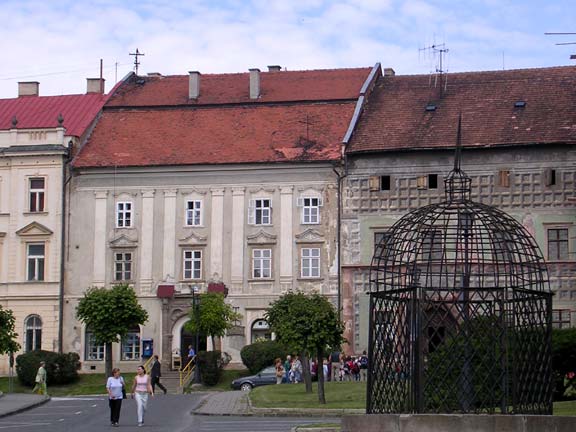 |
City Museum, the Old Court House 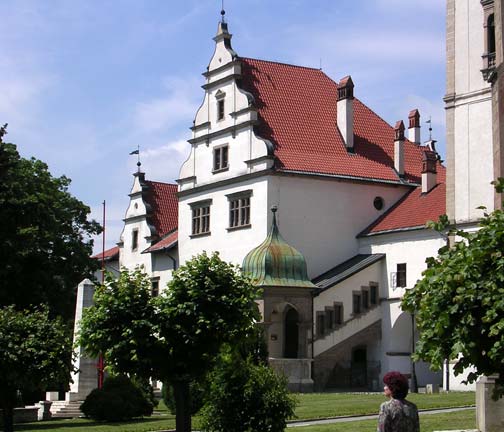 |
Church on the Hill 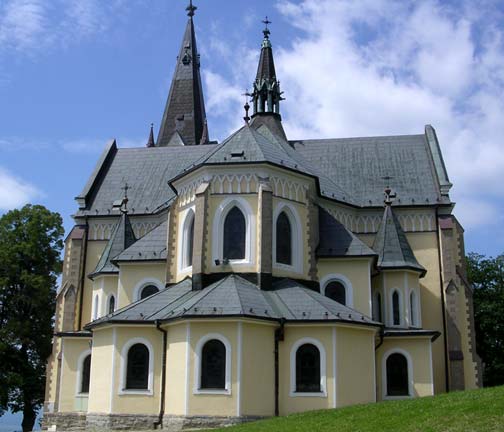 |
Today, Thursday, the first of July, we started with a walk around Levoča, visiting a museum and viewing all the building on the town square. Then we visited a church on hill overlooking the town. We have heard that there is a great pilgrimage to the church every July. It is a simple but pretty church from which the Pope in recent years addressed the people of Slovakia.
Then we were on the road to visit the ruins of the castle Spissky hrad, just a few miles east of Levoča. This is the largest ruins in Slovakia, if not all Europe. The castle was from the 13th century and was used until the mid 1700's, when a fire destroyed it.
From here we traveled to yet another UNESCO site, the church in Bardejov. It is famous for its three winged carved displays called a tripict. Its wood carvings were created in the 1460's through the 1480's.
Spissky Hrad 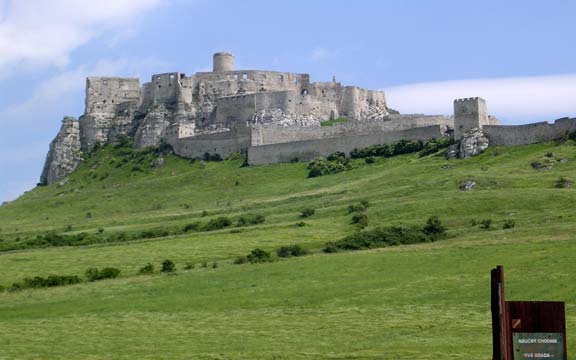 |
In the Castle 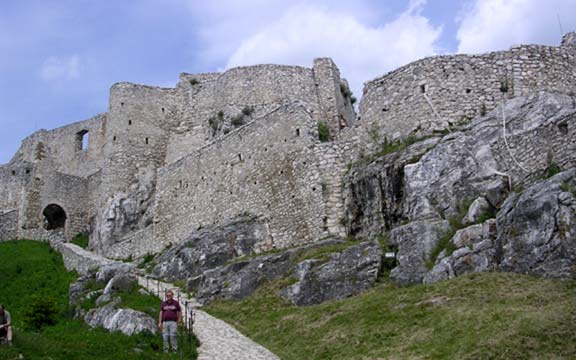 |
We arrived in Koice, the second largest city in Slovakia, about five PM. Like most of the cities we have seen in the east, it had a huge number of 12-story apartment buildings surrounding a beautiful inner core. Such an arrangement makes for very compact cities, but in a small place like Levoča it seemed out of place. The tourist housing was quite expensive, but we were able to find a reasonably price room. The hotel clerk/receptionist was a bitch, a real Brun Hilde. When we were trying to get clear about the hotel services she said to us, 'Well, you're not in the USA now!' To say that we did not feel a warm and welcoming atmosphere would be accurate. We decided to walk around the extensive central town square that evening and leave the next day for Hungary. The town square was fantastic, almost a half-mile long. We were able to meet some students, and then we ate dinner at a pub.
Our problem with the hotel clerk stemmed from again laundry problems. The problem with these eastern countries is that they have no laundries. For me who has been everywhere, this is and continues to be unbelievable. The snooty hotel staff could not accept our disbelief. Oh, yes the hotel could clean our clothes - but based on my experience in Brno, I would have nothing to do with the hotel washing our clothes.